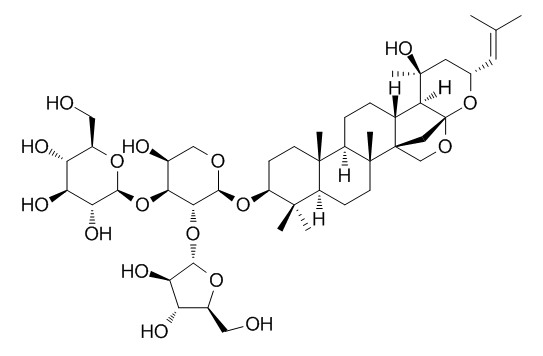Bacopaside X
Bacopaside X (9.06 μM) showed binding affinity towards the D1 receptor.
Inquire / Order:
manager@chemfaces.com
Technical Inquiries:
service@chemfaces.com
Tel:
+86-27-84237783
Fax:
+86-27-84254680
Address:
1 Building, No. 83, CheCheng Rd., Wuhan Economic and Technological Development Zone, Wuhan, Hubei 430056, PRC
Providing storage is as stated on the product vial and the vial is kept tightly sealed, the product can be stored for up to
24 months(2-8C).
Wherever possible, you should prepare and use solutions on the same day. However, if you need to make up stock solutions in advance, we recommend that you store the solution as aliquots in tightly sealed vials at -20C. Generally, these will be useable for up to two weeks. Before use, and prior to opening the vial we recommend that you allow your product to equilibrate to room temperature for at least 1 hour.
Need more advice on solubility, usage and handling? Please email to: service@chemfaces.com
The packaging of the product may have turned upside down during transportation, resulting in the natural compounds adhering to the neck or cap of the vial. take the vial out of its packaging and gently shake to let the compounds fall to the bottom of the vial. for liquid products, centrifuge at 200-500 RPM to gather the liquid at the bottom of the vial. try to avoid loss or contamination during handling.
Plant Methods.2017, 13:108
Nat Prod Sci.2014, 20(3):182-190
Hum Exp Toxicol.2023, 42:9603271231171642.
Babol University of Medical Sciences2024, rs-4289336
Antioxidants (Basel).2020, 9(2):E120
Pharmaceuticals (Basel).2021, 14(6):588.
Pol J Microbiol.2021, 70(1):117-130.
Univerzita Karlova2022, 228192.
BMC Complement Altern Med.2019, 19(1):11
Journal of Third Military Medical University2018, 40(12):1073-1078
Related and Featured Products
PLoS One. 2015 May 12;10(5):e0126565.
In Silico and In Vitro Analysis of Bacoside A Aglycones and Its Derivatives as the Constituents Responsible for the Cognitive Effects of Bacopa monnieri.[Pubmed:
25965066 ]
Bacopa monnieri has been used in Ayurvedic medicine to improve memory and cognition. The active constituent responsible for its pharmacological effects is bacoside A, a mixture of dammarane-type triterpenoid saponins containing sugar chains linked to a steroid aglycone skeleton. Triterpenoid saponins have been reported to be transformed in vivo to metabolites that give better biological activity and pharmacokinetic characteristics. Thus, the activities of the parent compounds (bacosides), aglycones (jujubogenin and pseudojujubogenin) and their derivatives (ebelin lactone and bacogenin A1) were compared using a combination of in silico and in vitro screening methods.
METHODS AND RESULTS:
The compounds were docked into 5-HT1A, 5-HT2A, D1, D2, M1 receptors and acetylcholinesterase (AChE) using AutoDock and their central nervous system (CNS) drug-like properties were determined using Discovery Studio molecular properties and ADMET descriptors. The compounds were screened in vitro using radioligand receptor binding and AChE inhibition assays. In silico studies showed that the parent bacosides were not able to dock into the chosen CNS targets and had poor molecular properties as a CNS drug. In contrast, the aglycones and their derivatives showed better binding affinity and good CNS drug-like properties, were well absorbed through the intestines and had good blood brain barrier (BBB) penetration. Among the compounds tested in vitro, ebelin lactone showed binding affinity towards M1 (Ki = 0.45 μM) and 5-HT2A (4.21 μM) receptors. Bacoside A and Bacopaside X (9.06 μM) showed binding affinity towards the D1 receptor.
CONCLUSIONS:
None of the compounds showed any inhibitory activity against AChE. Since the stimulation of M1 and 5-HT2A receptors has been implicated in memory and cognition and ebelin lactone was shown to have the strongest binding energy, highest BBB penetration and binding affinity towards M1 and 5-HT2A receptors, we suggest that B. monnieri constituents may be transformed in vivo to the active form before exerting their pharmacological activity.
Chem Pharm Bull (Tokyo). 2006 Jun;54(6):907-11.
Estimation of twelve bacopa saponins in Bacopa monnieri extracts and formulations by high-performance liquid chromatography.[Pubmed:
16755069]
METHODS AND RESULTS:
A simple and sensitive reversed phase high performance liquid chromatographic (HPLC) method has been developed for the simultaneous determination of twelve bacopa saponins present in the extracts of the Indian Medicinal Plant, Bacopa monnieri. The separation was achieved on a reversed phase C(18) column (Luna C(18)), 5 microm by isocratic elution with 0.05 M sodium sulphate buffer (pH 2.3) and acetonitrile (68.5 : 31.5, v/v) as the mobile phase at a flow rate of 1.0 ml/min with an operating temperature of 30 degrees C. The method was validated for linearity, precision, intra- and inter-day precision and accuracy. Several Bacopa samples (plant materials, extracts and commercial formulations) were successfully analyzed. Major bacopasaponins were bacosides A(3) (3), bacopaside II (4), bacopaside I (5), Bacopaside X (6), bacopasaponin C (7), bacopaside N2 (9) and the minor components were bacopasaponin F (1), bacopasaponin E (2), bacopaside N1 (8) bacopaside III (10), bacopaside IV (11) and bacopaside V (12).
CONCLUSIONS:
The total saponin content in the samples, plant materials and extracts varied from 5.1 to 22.17% and 1.47 to 66.03 mg/capsule or tablet in the commercial formulations.



